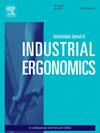Influence of surface curvature and pinch span on the maximal force exertion of pinch grip: a prospective cohort study
IF 3
2区 工程技术
Q2 ENGINEERING, INDUSTRIAL
International Journal of Industrial Ergonomics
Pub Date : 2025-08-22
DOI:10.1016/j.ergon.2025.103800
引用次数: 0
Abstract
This study investigated how the pinch surface curvature and pinch span influence the maximal voluntary pinch grip forces (MVFs) for different pinch types. Twelve male participants (age range: 22–34) underwent MVF measurements using a pinch grip on a dynamometer with six interchangeable attachment surfaces. They were randomly assigned to either a concave or convex handle group, each tested with three pinch spans (3, 5, and 7 cm) using a custom-designed dynamometer (Model T.K.K. 1269m and TSA-210; Takei Scientific Instruments Co., Ltd.). The pinch type was controlled as a tip, three-jaw, or key pinch, and both the dominant and non-dominant hands were examined. After completing the trials for each condition, participants rated their overall comfort, perceived fit, and perceived difficulty on a 5-point rating scale. We demonstrated that the concave surface was associated with greater MVFs than the convex surface (p < 0.01). However, the difference in MVF was insignificant when the pinch span was increased to 7 cm. The key pinch and dominant hand showed higher MVFs, better fit, and lower difficulty than their counterparts (key pinch: ps < 0.05; dominant hand: ps < 0.01). This study provides evidence on the design of pinch surface curvature and span that can effectively enhance MVF performance under varying pinch span conditions.
面曲率和捏握间距对捏握最大力发挥影响的前瞻性队列研究
本文研究了不同夹握类型下,夹握面曲率和夹握跨度对最大自主夹握力的影响。12名男性参与者(年龄范围:22-34岁)接受了MVF测量,使用一个夹握在6个可互换的附着表面的测力计上。他们被随机分配到凹柄组或凸柄组,每个组使用定制设计的测力计(型号T.K.K. 1269m和TSA-210;武井科学仪器有限公司)进行三个捏距(3,5和7厘米)的测试。捏捏类型被控制为尖捏、三颚捏或键捏,并且检查了优势手和非优势手。在完成每种条件的试验后,参与者对他们的整体舒适度、感知契合度和感知困难度进行了5分制的评分。我们证明了凹表面比凸表面与更大的MVFs相关(p < 0.01)。当夹紧间距增加到7 cm时,MVF的差异不显著。键捏和优势手的MVFs值较高,配合度较好,难度较低(键捏:ps <; 0.05;优势手:ps <; 0.01)。研究结果表明,在不同夹紧跨度条件下,夹紧曲面曲率和夹紧跨度的设计可以有效地提高MVF的性能。
本文章由计算机程序翻译,如有差异,请以英文原文为准。
求助全文
约1分钟内获得全文
求助全文
来源期刊
CiteScore
6.40
自引率
12.90%
发文量
110
审稿时长
56 days
期刊介绍:
The journal publishes original contributions that add to our understanding of the role of humans in today systems and the interactions thereof with various system components. The journal typically covers the following areas: industrial and occupational ergonomics, design of systems, tools and equipment, human performance measurement and modeling, human productivity, humans in technologically complex systems, and safety. The focus of the articles includes basic theoretical advances, applications, case studies, new methodologies and procedures; and empirical studies.

 求助内容:
求助内容: 应助结果提醒方式:
应助结果提醒方式:


